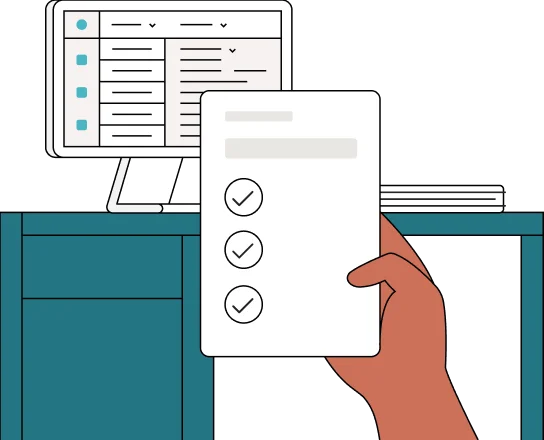Setting up a living trust has definite benefits, from helping to avoid lengthy probate proceedings to ensuring your loved ones are supported even after your death. Creating one yourself can save you on legal bills that you would otherwise spend hiring an estate planning attorney, although there are important challenges that you should consider when making a DIY revocable living trust.

What is a living trust?
A living trust is a legal document that holds and manages your assets during your lifetime and transfers them directly to your chosen beneficiaries after your death—without going through probate court. As the grantor, you appoint a trustee to control the trust and distribute assets according to your instructions.
A living trust is often referred to as a revocable living trust, which means that you can change the trust at any time, revoke it, or make alterations to it.
Why consider a living trust?
Both living trusts and wills distribute your assets to beneficiaries after your death. However, living trusts offer distinct advantages:
- Probate. With a will, a probate court oversees asset distribution in an oftentimes costly and time-consuming probate process. Living trusts transfer your assets directly to your beneficiaries once you die.
- Privacy protection. Unlike wills, which become public record during probate, living trusts remain completely private.
- Lifetime control. You can act as your own trustee and maintain full control of your assets while alive, then designate a successor trustee to take over when needed.

What is a do-it-yourself (DIY) living trust?
A DIY living trust is a trust you create on your own using online forms, templates, or legal services like LegalZoom—without hiring an estate-planning attorney to draft documents or provide personalized legal advice. Typically, this approach works best for straightforward estates with uncomplicated assets and beneficiaries.
You can create your own living trust with thorough research and a solid understanding of estate planning. If you want more guidance without giving up control, LegalZoom offers DIY estate plans that include access to licensed attorneys.
If you decide to take a do-it-yourself approach without an attorney guiding you, you'll need to develop a solid understanding of the most important points of a trust, such as the following:
- Naming a trustee whom you can rely on to manage and safely transfer your assets
- Naming your beneficiary or beneficiaries
- Choosing which assets to include in your trust
- Staying informed on estate tax and other local and federal laws that will impact your trust
DIY living trust pros and cons
Depending on your estate's circumstances, creating a trust without legal guidance may work well, especially for straightforward estates. Here are a few points to consider.
| Pros | Cons |
| Saves money on upfront legal fees | May lead to higher taxes without expert knowledge of tax laws |
| Simplifies the process for uncomplicated assets | May overlook state-specific requirements, risking probate |
| Handle the process independently on your schedule | May not account for special circumstances like blended families or special needs children |
For more complex estates, the benefits of hiring an attorney typically outweigh the cost. Trust laws can get complicated very quickly, and large estates have the most to lose when details are overlooked.
Ultimately, it's a good idea to have an attorney look at your trust or set it up for you, especially if you have a large estate.

How to set up a living trust yourself in 7 steps
A DIY trust may sound simple, but it still requires adequate preparation, contemplation, and action that vary based on the needs of your trust and the location of your assets. Follow these seven steps to set up your living trust.
Step 1: Collect information
To formally transfer ownership of your assets, you first have to prove that those assets belong to you. Find deeds, titles, and other documents that prove ownership of your property, including account information or stock certificates for intangible assets. Then, make a list of your intended beneficiaries.
Step 2: Choose the type of trust
A living trust—also called a revocable living trust—is the most basic type of trust. Depending on several factors, you can choose between several types of revocable living trusts.
It's called a revocable trust because it allows you to modify or revoke your trust at any time. An irrevocable trust is more complex to set up, and you can't change or revoke it except under very limited circumstances and with the consent of the beneficiaries. Irrevocable trusts offer more asset protection for those who need it, and assets placed in an irrevocable trust aren't subject to estate tax upon death.
Step 3: Name a trustee and a successor trustee
Your trust determines how assets transfer to loved ones if you become incapacitated or die, so choosing a reliable trustee is critical. As the grantor, you can name yourself as trustee and your spouse as co-trustee. However, you must also name a successor trustee to take over if something happens to both of you.
Step 4: Draft the trust document
After deciding what assets to include and who will be involved, prepare the trust agreement (also called a declaration of trust). This document identifies the trustee and beneficiaries and sets the rules for asset distribution.
You can create the document using online templates, DIY kits, or estate planning services like LegalZoom. Just make sure to customize the document to fit your unique needs and comply with your state's laws.
Step 5: Get a trust review
While using online tools such as the ones listed above can save you upfront costs and potentially simplify the process, there are always risks involved in creating a DIY trust without having the document at least reviewed by a legal professional. Getting a trust review will likely be less expensive than hiring an attorney to set up the entire trust for you.
Step 6: Sign and notarize
Once your trust is prepared, you must typically execute it by signing in front of a notary public and/or witnesses. Requirements vary by state, so verify your local rules.
Here are a few examples.
- California and Nevada: Notarization required
- Texas and Illinois: Notarization not required
- New York: Notary or two witnesses required
Step 7: Transfer assets to the trust
To ensure your trust works, you must transfer ownership of assets into the trust by changing titles and updating beneficiary designations. How you transfer assets will depend on what the asset is and where it's currently housed.
- Real estate: You can use a quitclaim or warranty deed to transfer property. Get the deed notarized and file it with your county clerk, then verify the transfer with a title insurance company.
- Financial accounts: Contact your bank or investment institution to transfer accounts into the trust's name. You may need to close existing accounts and reopen them under the trust.
- Business interests: Review your operating agreement (LLCs) or bylaws (corporations) for transfer procedures. Execute an "assignment of interest" to transfer ownership to the trust.
Keep your trust documents in a secure but accessible location—though, you don't need to file them with any court or agency.

What goes into a trust?
Once you decide who you want to be involved in your trust, you have to choose the assets that will go into the trust. You can select any assets you want.
Here are some examples of assets commonly put into trusts:
- Real estate property
- Financial assets
- Stocks
- Bonds
- Mutual funds
- Valuable items, such as jewelry or artwork
- Insurance policies
- Business interests or ownership
- Cryptocurrency
To place the assets in the trust, you need to change the legal ownership of the assets from your name to that of the trust. So for real estate, you will need a new deed. For financial accounts, you transfer the ownership to the trust as well.
When you should consider hiring a lawyer for your living trust
If the following scenarios apply to you, it's wise to seek legal counsel when building your living trust:
- Your estate involves multiple properties in multiple states
- Your estate involves large sums of money or complex tax considerations
- You want to impose detailed conditions on when or how beneficiaries receive their inheritance
- You have beneficiaries with special needs or concerns
- You have a large or blended family, and your living trust may require a firm hand to avoid disputes
Living trusts are just one tool—along with last wills and life insurance policies—to provide for your family after your passing.
Creating a living trust is about more than filling out a legal document. It ensures that your assets are properly protected and your loved ones are adequately supported even after you’re gone. If you have complex estate planning needs, an attorney can create a legally sound trust that aligns with state laws and safeguards your assets.
From naming beneficiaries to setting conditions, see what you can customize in your trust.

DIY living trust FAQs
Can you set up a trust without an attorney?
Yes, an attorney is not legally required to create a trust. However, depending on your circumstances, you may want the legal guidance of an experienced estate attorney to ensure your trust contains the right information to truly safeguard your loved ones in the future. If you feel that your situation is straightforward enough that you can do it DIY, we recommend at least getting a trust review after completing your documents!
Do I need a last will and testament if I have a living trust?
If you have a trust, you should also have a type of will called a “pour-over will,” which serves as a backup to the trust. However, if you have a last will, you don’t necessarily need a trust, although it’s not a bad idea to have both. A will also allows you to name guardians for your minor children and custodians for pets.
What are some alternatives to a living trust?
A clear and unambiguous last will can also transfer your assets appropriately. You can also opt for a Transfer on Death (TOD) or Payable on Death (POD) account, a financial account that your bank transfers to a beneficiary when you pass. However, a TOD only allows you to name a primary beneficiary and a secondary beneficiary, and typically requires equal division between the two.
Can a living trust help save on estate taxes?
Yes, certain trust structures can reduce estate taxes, but effectiveness depends on your state's tax laws and how the trust is structured. Consult an estate planning attorney for advice specific to your circumstances and state.
Brette Sember, J.D., contributed to this article.


